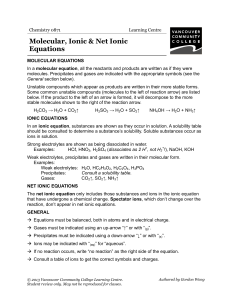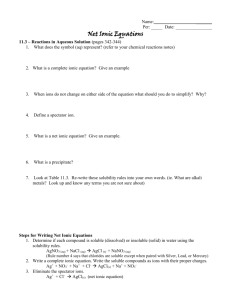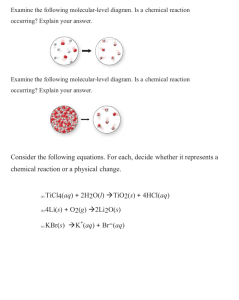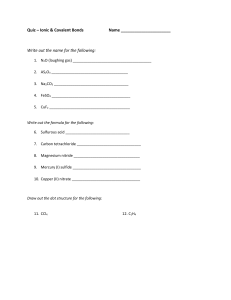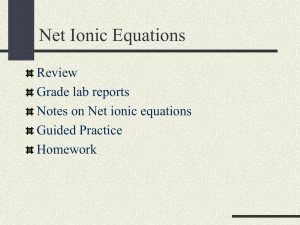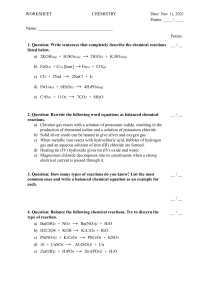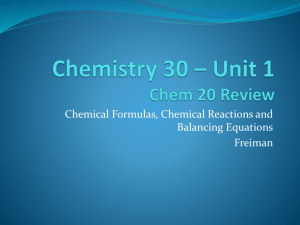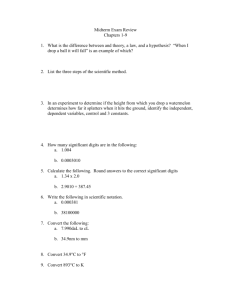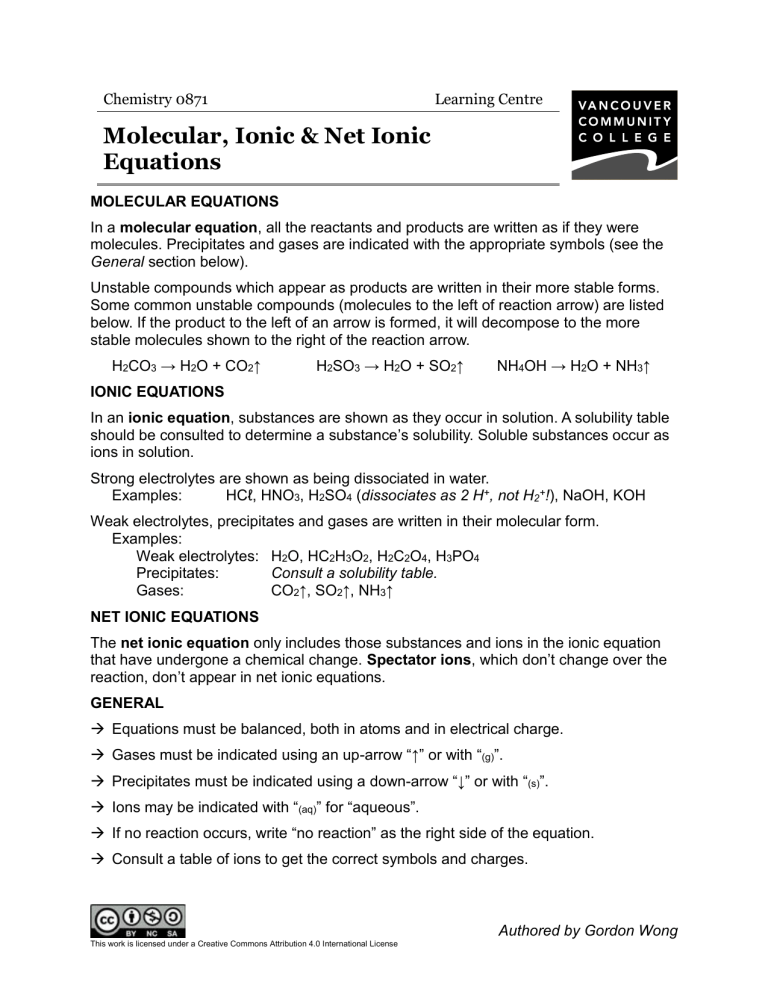
Chemistry 0871 Learning Centre Molecular, Ionic & Net Ionic Equations MOLECULAR EQUATIONS In a molecular equation, all the reactants and products are written as if they were molecules. Precipitates and gases are indicated with the appropriate symbols (see the General section below). Unstable compounds which appear as products are written in their more stable forms. Some common unstable compounds (molecules to the left of reaction arrow) are listed below. If the product to the left of an arrow is formed, it will decompose to the more stable molecules shown to the right of the reaction arrow. H2CO3 → H2O + CO2↑ H2SO3 → H2O + SO2↑ NH4OH → H2O + NH3↑ IONIC EQUATIONS In an ionic equation, substances are shown as they occur in solution. A solubility table should be consulted to determine a substance’s solubility. Soluble substances occur as ions in solution. Strong electrolytes are shown as being dissociated in water. Examples: HCℓ, HNO3, H2SO4 (dissociates as 2 H+, not H2+!), NaOH, KOH Weak electrolytes, precipitates and gases are written in their molecular form. Examples: Weak electrolytes: H2O, HC2H3O2, H2C2O4, H3PO4 Precipitates: Consult a solubility table. Gases: CO2↑, SO2↑, NH3↑ NET IONIC EQUATIONS The net ionic equation only includes those substances and ions in the ionic equation that have undergone a chemical change. Spectator ions, which don’t change over the reaction, don’t appear in net ionic equations. GENERAL Equations must be balanced, both in atoms and in electrical charge. Gases must be indicated using an up-arrow “↑” or with “(g)”. Precipitates must be indicated using a down-arrow “↓” or with “(s)”. Ions may be indicated with “(aq)” for “aqueous”. If no reaction occurs, write “no reaction” as the right side of the equation. Consult a table of ions to get the correct symbols and charges. Authored by Gordon Wong This work is licensed under a Creative Commons Attribution 4.0 International License Example 1: Write correct molecular, ionic and net ionic equations for the following: 1) NaCℓ(aq) + AgNO3 (aq) → _____ 2) Na2CO3 + HCℓ → _____ Solution: 1) Molecular: NaCℓ(aq) + AgNO3 (aq) → AgCℓ(s) + NaNO3 (aq) Ionic: Na+(aq) + Cℓ−(aq) + Ag+(aq) + NO3−(aq) → AgCℓ(s) + Na+(aq) + NO3− (aq) Since the sodium and nitrate ions are on both sides: Net Ionic: Ag+(aq) + Cℓ−(aq) → AgCℓ(s) 2) When balanced, the double displacement reaction is: Na2CO3 + 2 HCℓ → 2 NaCℓ + H2CO3 But H2CO3 is unstable, so: Molecular: Na2CO3 + 2 HCℓ → 2 NaCℓ + H2O + CO2↑ Ionic: 2 Na+ + CO3− + 2 H+ + 2 Cℓ− → 2 Na+ + 2 Cℓ− + H2O + CO2↑ Since the sodium and chlorine ions are spectators: Net Ionic: 2 H+ + CO3− → H2O + CO2↑ EXERCISES A. Write correct molecular, ionic and net ionic equations for the following: 1) NaBr + AgNO3 → 6) Na2SO4 + BaCℓ2 → 2) ZnSO4 + BaCℓ2 → 7) Ca(NO3)2 + (NH4)2CO3 → 3) CuCℓ2 + Pb(NO3)2 → 8) (NH4)2SO4 + LiNO3 → 4) NaCℓ + KNO3 → 9) Na2CO3 + HBr → 5) NaC2H3O2 + HCℓ → 10) NaOH + HCℓ → SOLUTIONS A. (1) M: NaBr + AgNO3 → NaNO3 + AgBr↓; I: Na+ + Br− + Ag+ + NO3− → Na+ + NO3− + AgBr↓; NI: Ag+ + Br− → AgBr↓ (2) M: ZnSO4 + BaCℓ2 → ZnCℓ2 + BaSO4↓; I: Zn2+ + SO42− + Ba2+ + 2 Cℓ− → Zn2+ + 2 Cℓ− + BaSO4↓; NI: Ba2+ + SO42− → BaSO4↓ (3) M: CuCℓ2 + Pb(NO3)2 → Cu(NO3)2 + PbCℓ2↓; I: Cu2+ + 2 Cℓ− + Pb2+ + 2 NO3− → Cu2+ + 2 NO3− + PbCℓ2↓; NI: Pb2+ + 2 Cℓ− → PbCℓ2↓ (4) M: NaCℓ + KNO3 → no reaction (5) M: NaC2H3O2 + HCℓ → NaCℓ + HC2H3O2; I: Na+ + C2H3O2− + H+ + Cℓ− → Na+ + − Cℓ + HC2H3O2; NI: H+ + C2H3O2− → HC2H3O2 (6) M: Na2SO4 + BaCℓ2 → 2 NaCℓ + BaSO4↓; I: 2 Na+ + SO42− + Ba2+ + 2 Cℓ− → 2 Na+ + 2 Cℓ− + BaSO4↓; NI: Ba2+ + SO42− → BaSO4↓ (7) M: Ca(NO3)2 + (NH4)2CO3 → CaCO3↓ + 2 NH4NO3; I: Ca2+ + 2 NO3− + 2 NH4+ + CO32− → CaCO3↓ + 2 NH4+ + 2 NO3−; NI: Ca2+ + CO32− → CaCO3↓ (8) M: (NH4)2SO4 + LiNO3 → no reaction (9) M: Na2CO3 + 2 HBr → 2 NaBr + H2O + CO2↑; I: 2 Na+ + CO32− + 2 H+ + 2 Br− → 2 Na+ + 2 Br− + H2O + CO2↑; NI: 2 H+ + CO32− → H2O + CO2↑ (10) M: NaOH + HCℓ → NaCℓ + H2O; I: Na+ + OH− + H+ + Cℓ− → Na+ + Cℓ− + H2O; NI: H+ + OH− → H2O This work is licensed under a Creative Commons Attribution 4.0 International License 2
